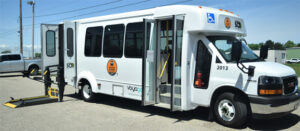 All of our regular buses are equipped with an accessible wheelchair lift, which can be used by passengers with limited mobility or who use a mobility aid such as a wheelchair. Important Note: the Summer Bus is not equipped with a wheelchair lift.
All of our regular buses are equipped with an accessible wheelchair lift, which can be used by passengers with limited mobility or who use a mobility aid such as a wheelchair. Important Note: the Summer Bus is not equipped with a wheelchair lift.
Mobility scooters are welcome. To use the accessible lift, the scooter must fit into a 48-inch (1.22m) long by 36-inch (91cm) wide space.
If able, we encourage scooter passengers to transfer to a fixed seat when on the vehicle, as some scooter designs cannot be secured firmly enough to carry a seated passenger when the bus is in motion.
Using the Wheelchair Lift
The Wheelchair lift can only be used to move passengers and mobility equipment, such as wheelchairs, appropriately sized scooters and walkers. Mobility equipment must have brakes and be able to be secured at one of the two wheelchair stations.
When using a walker on the lift, the walker’s brakes must be engaged, and the passenger must hold onto the handles as the lift is put into motion.
Non-mobility equipment items that do not have brakes or cannot be secured for lift operation or at the wheelchair stations cannot go onto the lift.
If the passenger has a backpack and is seated in a wheelchair, the backpack should remain worn by the passenger or held on their lap when the lift is in operation. Bags hanging off the wheelchair must be removed and brought onto the bus separately. This is due to the importance of proper balance of the mobility device and the passenger when on the wheelchair lift.
Carry-On Items
All passengers, including accessibility passengers, must be able to manage carry-on items, such as backpacks, purses, briefcases, suitcases, tote bags and shopping bags themselves without the driver’s help. If this is not possible, please bring a Support Person or a companion to help.
Drivers are not required to assist with carry-on items at any time.
Carry-on items are not allowed to stick out from a mobility aid or assistive device as this may interfere with the safe securement of the device.
Place carry-on items on your lap or the floor to minimize the space and impact on other customers.
Please consider that any item not secured becomes a potential projectile when the bus is in motion and creates a dangerous situation for everyone on board.
Bus Stops
In cases where a transit stop is temporarily inaccessible, people with disabilities can board or exit the bus at the closest safe location. In determining where a safe location is located, the operator will consider the preference of the person with a disability, however, the final determination of the safe location will be determined by the operator.
Priority Seating
Priority Seating is for the use of passengers with a disability. Each bus is equipped with a designated location found at the rear of the bus for persons using a wheelchair or other mobility aid. If you do not have a disability or mobility challenge, please vacate these seats when asked by a person with a disability or the bus operator.
Service Animals
Passengers with disabilities who are accompanied by their service animal are welcome on our vehicles. Service animals must be clearly identified (such as by a vest or harness), and must be in the care and control of their owner at all times (Ontario Regulation 429/07 of the Accessibility for Ontarians with Disabilities Act, 2005, S.O. 2005, c. 11).
Under the Accessibility for Ontarians with Disabilities Act (https://aoda.ca/service-animal-laws-for-ontario-workplaces/), a service animal for a person with a disability is an animal readily identified as a service animal due to its vest or harness OR the passenger provides documentation from a member of one of the following regulated health professions confirming the animal is needed for reasons relating to the passenger’s disability:
- A member of the College of Audiologists and Speech-Language Pathologists
- A member of the College of Chiropractors
- A member of the College of Nurses
- A member of the College of Occupational Therapists
- A member of the College of Optometrists
- A member of the College of Physicians and Surgeons
- A member of the College of Physiotherapists
- A member of the College of Psychologists
- A member of the College of Registered Psychotherapists and Registered Mental Health Therapists
Support Person
Support Persons accompanying a passenger with a disability are permitted to ride the bus for free. A support person is someone who assists a person with a disability, with communication, mobility, personal care/medical needs, or with access to goods, services or facilities. The support person does not have to be the same person for each trip.

